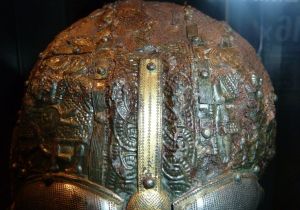Helmet from Vendel Cemetery, burial XIV. Observe the nose-protector in the shape of the beak of a raven (a very important bird in the Scandinavian cosmology).
Vendel helmet reconstruction by Ivor Lawton (copyright).
.
By Periklis Deligiannis
.
The Vendel period of the history of Sweden and essentially of the whole area of eastern and southern Scandinavia (of course including modern Denmark) is the era before the Viking Age (793 – early 11th century AD). It lasted from the mid-6th century AD to the end of the 8th century and is characterized by princely burials of warlords and powerful warriors with impressive weapons. This historical period and the homonym cultural conglomerate (Vendel culture) took their name from the site Vendel at the historical district Uppland in eastern Sweden, north of Old Uppsala, the ancient centre of the Svear kings. The most characteristic cemeteries were found there. It seems that Uppland (where later the important cities of the Viking age Uppsala and Sigtuna were developed) was very important politically during the Vendel period. The area was rather the political center of the tribe of the Svears (Latin Suiri and Suirones and according to Jordanes: Suehans, Nordic: Svear, Anglo-Saxon: Sweonas, modern Swedes) who had extended to it earlier coming from Svealand, their core territory in the south. Uppland means the upper land, the land in the north.
Another very important archaeological site of the Vendel period is Valsgärde, a place about three kilometres north of Old Uppsala. The tombs excavated at Valsgärde gave findings of the same type as those of the Vendel archaeological site. Ulltuna is another important site of this period. The influence of the Vendel culture does not seem to have been strong in western Scandinavia, i.e. modern Norway (Iceland and the Faeroe Isles were not yet inhabited by Scandinavians).
The later known Nordic kingdoms or ‘nations’ had not yet been developed during the Vendel age. Scandinavia was inhabited by numerous North Germanic tribes and clans who were almost in constant war with each other. Even the sub-tribes and clans of the larger tribes were politically independent from each other, constantly fighting one another. It seems that at times powerful warlords appeared establishing ephemeral principalities or kingdoms. This is the time and the societies described in the Anglo-Saxon epic poem Beowulf, an epic possibly of Jute or Gott/Gotar origins (see part II).
The burials in the Vendel cemeteries contained rich weaponry from which the renowned helmets excavated there stand out. In this series of articles we present a collection of images of the original helmets and a series of modern reconstructions of them. We include the Sutton Hoo helmet in this presentation because several researchers consider the Sutton Hoo burial as a part of the Vendel general cultural conglomerate.

A Vendel-type helmet from the Ulltuna cemetery

Reconstruction of the helmet from the Ulltuna cemetery by Thorkil (copyright: Thorkil).

Map of Vendel period eastern and southern Scandinavia. The tribes noted are the ones mentioned mainly in Beowulf. The main archaeological sites are also noted, including Vendel, Valsgärde and Old (Gamla) Uppsala in Uppland (top right).

Helmet found in the Valsgärde cemetery.

Detail of another helmet found at Valsgärde.

A reenactment of a Nordic warrior wearing a reconstructed Vendel type helmet. Note the lamellar armor, an influence on the Scandinavian weaponry by the steppe peoples (Sarmatians, Alans and Huns) via the continental Germanics. The Vendel helmets had also design influences from the nomadic peoples.

A Scandinavian horseman in an ornamental plate of the Vendel period, wearing a helmet of the homonym type. Note the crest of the helmet in the form of a raven.

Helmet found at Vendel, grave I, 7th century.

A fine reconstruction of a helmet found at Vendel, grave I.

Detail of the skull of a Valsgärde helmet.
.
(I’m sorry for not mentioning all the reconstructors, reenactors or owners of the reconstructed and reproduced helmets in this series of articles but I neither know them nor have the needed time to find them. If someone knows who they are, please inform me but only by reference to the official site or other reliable source. Thank you in advance).
.
In the second and third part I will present more pictures of helmets and I shall deal in more detail with the tribes and the clans of Sweden, Denmark and Norway during the Vendel period.
.
Periklis Deligiannis
.
CONTINUE READING IN PART II
.









Feb 04, 2015 @ 20:49:54
Dec 05, 2018 @ 10:46:11
Germanic tribes and slavic tribes were wearing lamela armor way before huns or any nomadic person was.